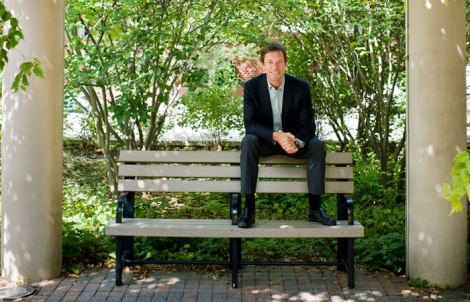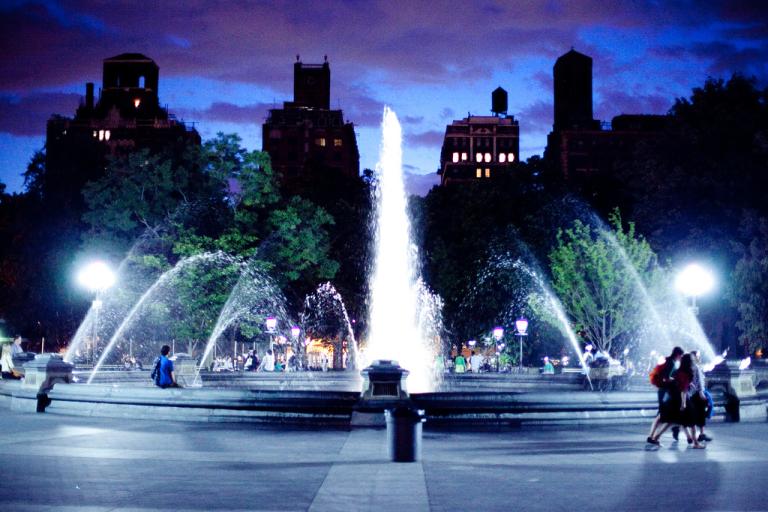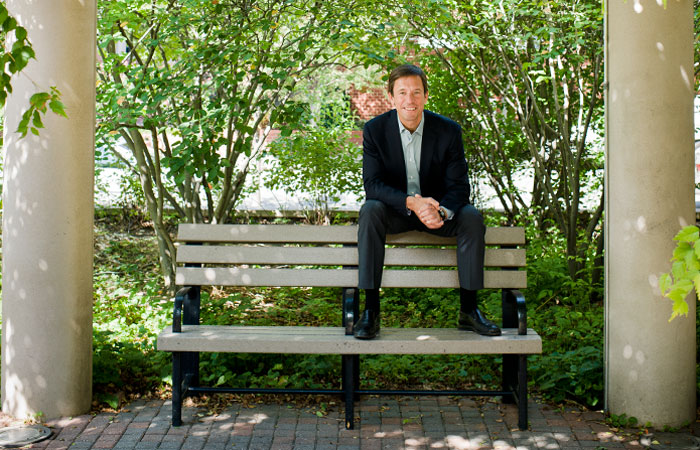
Dave Lauridsen
Mark Tercek leads the largest conservation group in the galaxy. As president and CEO of the Nature Conservancy, he oversees a staff of 4,000 people spread around the planet, an annual budget exceeding a half-billion dollars, and land holdings that would fetch billions more if they weren’t all locked up for the sake of protecting wild animals. Still, the former Goldman Sachs exec insists that he’s a small-time player in a world where large corporations rule and nature lovers get what they can.
In his recent book, Nature’s Fortune, co-authored by Jonathan Adams, Tercek argues that nature deserves a bigger slice of the pie. He’s not looking for handouts (though his organization, like Grist, depends on the generosity of good people like you). Instead, he argues that conservation is good for business — a message he says is catching on, particularly among corporations and cities.
Witness New York. In the 1990s, faced with the prospect of building a multi-billion-dollar water treatment system, the city instead invested in protecting its watershed in the Catskills, partnering with communities, landowners, and farmers to prevent pollution, rather than paying to clean it up after the fact. As a result, the Big Apple gets clean drinking water at a fraction of what it would cost to build water treatment plants, and the Catskills get an infusion of green — trees, yes, but also cash. (Tercek and Adams tell that story in the book, in a section that we’ve reprinted here.) The Nature Conservancy is now helping to spread that model to cities all over the world.
Tercek dropped by Grist HQ a few weeks ago for some vegan vittles and a chat with the whole staff. Here are a few of our questions, and snippets of his answers, about how his organization is changing with the times, the challenge of getting city people to care about conservation, and his dealings with the big businesses that make even the Nature Conservancy look small.
Q. Why should we be putting half a billion dollars a year into protecting nature as opposed to say, pushing solar and other renewable energy technology forward?
A. I think we should do both. That new technology should be pursued either by the government doing the right thing because the private sector’s not, or the private sector. Obviously there’s lots of ways to incentivize that private-sector investment — put a price on carbon. And there are enormous numbers of people who are rich, or powerful and influential, attracted to those initiatives. So they’re going pretty well.
In the meantime, we think the work we do is extraordinarily important. For example, in northwestern Montana, near Glacier National Park, there were 300,000 acres of land made available for purchase by us by Plum Creek. This land, just because of where it’s situated in between other protected areas, was extraordinarily attractive for development — second homes for well-to-do people. So we bought all that land in one swoop for half a billion dollars.
Now why is that important? Well, all the species that were there when Lewis and Clark were there are still there. So it’s extraordinary wilderness. And if climate change occurs like we expect it will, those grizzlies and lynx, they can migrate north up to B.C. — we’re doing comparable work right over the border. If we hadn’t done that, this land would have been developed, for sure, and this opportunity would be gone forever.
Q. Climate change has emerged to be the dominant issue in the green space. How has that changed the way the Nature Conservancy does its work?
A. Right before I joined, TNC decided to be in the policy arena in connection with climate change. That was a reasonably big decision. TNC happens to be one of the few conservation organizations that is determinedly nonpartisan, and actually does have friends on both sides of the aisle. That’s an asset, and that was something that my predecessors on the board were concerned about protecting. But we try to identify the biggest threats to our missions from a science lens, and identify the biggest tools to address those threats. And so our scientists reasonably said, climate change is not only a threat to what we want to do, it will undo everything we’ve already done. It trumps everything else. So then we said, OK, what’s the best way to address that? So we engaged in the policy battle.
And then it got really interesting. We were members of USCAP [the U.S. Climate Action Partnership]. I know USCAP was controversial, and anyway it didn’t succeed, although we got darn close. But it was a high-profile thing. So if you were a big donor who had misgivings about TNC being in the climate game, you would get a direct call from me to explain what we were doing. People would say, well, why are you doing the climate thing? And I would answer just like I did. And they would say, yes, that’s fair, you’re supposed to be science driven.
So mostly that has all died down. Now I think we are as much in that game as anyone, both in the international, domestic, and even state-by-state approaches. And it shows that these organizations have more resilience than you think. There was a lot of trepidation about that, but everyone’s been fine and we’re in the game.
Q. TNC has also made a recent shift to working in urban areas. What’s the thinking behind that?
A. If you came to a TNC event and looked around the audience, you would see well-to-do older white people. And if you say to them, how did you become a conservationist? They would often say, oh, when I was a kid, my grandparents had a ranch or a farm or took me hiking, that kind of thing.
So now you think about the future and you look at the data and you say, wow, young kids, they spend less than one-third of the time outdoors than people my age did. By 2030, something like 70 percent of the world’s people will live in cities. And obviously the world’s becoming more diverse. So what do we do about that?
I happen to have a city background. So when I arrived I asked our chief scientist, hey, how come we can’t do work in cities? And he said, oh there’s no reason we can’t, we just choose not to. And so then I sort of put the green light on — let’s find urban stuff — and it’s getting great traction.
We got a grant from Toyota to take inner-city kids, sometimes from really bad circumstances, and put them in our projects in the summer. I now know a lot of these kids, and often they just wanted a safe place to be in the summer when school was out of session. So they’d go out into nature for the first time in their life and a couple months later they’d be, like, walking the walk, wearing fleeces, the whole thing.
Now we have more than 500 graduates of that program [called LEAF]. Ninety-six percent of those kids go to college. Eighty-five percent of them are nonwhite. And more than one-third of them are majoring in life sciences like environmental studies and biology, whereas on average, 6 percent of Americans major in life sciences — and those that do are 82 percent white. And so we think we have real evidence that you can use nature in so many ways.
Q. You come out of the world of business and investing. Do people in that world understand what you’re doing now?
A. To be honest, the business guys are pretty smart. It’s the environmentalists, including my colleagues, who have more to learn here. I was at this Fortune conference this week — honestly, it’s so interesting to me, most business people who pay a little bit of attention to this, or make an effort to understand it, kind of get it. The pushback and criticisms is all from environmentalists.
I don’t want to be too critical of environmentalists, because these organizations are really good at getting things done. But I think we have some bad habits. We are quick to portray things as good vs. evil. And the closer I get to all this, I just think that’s usually not true. More often it’s grayer and more complex than that.
There’s two bad consequences of that. First, it turns off parties that we would want to work with. It discourages them from working with us. It also, I think, confuses environmentalists, because then they say the reason these things aren’t happening is that people are bad. But I could argue, and I think with real evidence, that sometimes the reason things that we want to see happen aren’t happening is because we haven’t had a good dialogue and explained things well, and we haven’t actually acknowledged holes in our argument.
Q. Give us an example of how you’re working with the corporate crowd.
A. We’re very much in the business of understanding and demonstrating that ecosystems can provide the most resilient, and most cost-effective protection from the bad consequences of climate change. The Dow [Chemical Co.] thing, which I write about in the book, is really interesting in its subtleties. The company’s CEO, Andrew Liveris, he gets it, so he says, we have an opportunity here at Dow to test these theories of TNC’s, and if they work, it should be good for our business. Also, we’re a global citizen, and we have a big environmental footprint; it’s the right thing for us to do, to be experimenting with this stuff.
I put together a team of really good scientists, and I sent them to Freeport, Texas, which is where Dow’s big facility is. One of our theories was that coastal ecosystems would provide better protection from storms — because the plant down there is right on the coast. So our scientists said to the engineers, what about storms? And they said, we’re ready for that. Here are our seawall plans. And they know everything, A to Z, about seawalls. And our guys said hey, well, have you thought about coastal ecosystems? And they said, no, sounds interesting. Show us your data. And we don’t have data to that same degree. And so we’ve gotta make that case. That’s the spirit of the project.
But then other stuff happened. We learned, just because we were hanging around down there, that as the plant expands they have to put in new scrubbers in their chimneys, to deal with local pollution issues. But then our scientists said, hey, I think tree plantings will do that. So then we checked into it — and this isn’t a done deal, but the EPA’s been very encouraging — but it could be the case that Dow will be able to save money, instead of putting scrubbers in chimneys, which of course do nothing for anyone, other than address the local pollution issues — they’ll be able to plant trees up and down the Brazos River. There are enormous co-benefits, even to Dow there, protecting that watershed, but community benefits too.
And then because of the way the wind patterns flow, Dow might be able to plant trees in Houston and get credit for dealing with their pollution issues. So now you’re not building scrubbers, you’re planting trees in a local area and protecting your watershed, and you’re planting trees in Houston — a fine city, but one that could use more trees.
This is exciting stuff. But that only happens if you get these parties together, get everyone to just shut up basically, and roll up their sleeves and work.
Q. The Nature Conservancy is working with companies like Dow and Coca-Cola that are spreading nasty chemicals and high-fructose corn syrup around the planet. It’s one thing to get corporations like that to green their operations, but can you get them to think a little more holistically about the stuff they’re putting out in the world?
A. It’s complicated, right? And don’t assume — don’t ascribe more power or clout to us than we have. But when I came, I had this view, or a theory, that we could do the kinds of things we’re doing with Dow, which is show them that they can improve their business and get better environmental outcomes. And so that’s what we’re trying to do with a bunch of companies — Cargill, Coke, Pepsi, Dow, Rio Tinto — these are the guys. So it’s controversial.
But other than folks on the far left, most folks seem OK with the thought. We tell them that we’re going to disclose everything as fast as we can. That way, if you see an opportunity for us to do something better, or if we’re making a mistake, you’ll tell us. We’re not trying to make money or anything. We’re trying to achieve our mission. Most people seem to think that’s reasonable.
Then you say, yeah but gosh, Coke’s product is so bad. And sometimes people say to me, Mark, you seem to be a person who has like healthy food habits, what the hell are you doing? But I — this may be romantic or naïve, but I think when we get people, like these Dow engineers, they were a little bit hostile, in fact, on arrival. Now they kinda like our scientists, because they’re likable guys and gals, they’re smart. And then because they’re working with us they go out in these ecosystems, look at them, understand how they work, and they kind of become environmentalists.
So I think we are going to turn our corporate allies into environmentalists. But you’re asking something even harder. You’re asking, what’s Coke going to do about its product, or how can they be an even nobler citizen? I don’t know the answer. And it’s not exactly TNC’s job. If Coke’s product is a bad product, I think the government has to say so. That’s my personal answer. I don’t think you can ask a business to not be a business.
Q. But if all you do is green your operations, it’s window dressing. If these corporations were serious about making a difference, wouldn’t they be in Washington, lobbying for smarter policies on climate, for example?
A. It’s hard to get companies to do the right thing. Look at fracking. Whenever I talk to an energy industry executive in the big companies, I say you, not us, YOU should be the champions of smart regulations. You’re screwed. Otherwise these small upstarts are going to create some disaster, you’re all going to get blamed, things are going to get shut down. What are you waiting for?
I think it’s absolutely in the energy industry’s interest to have the toughest regulation possible. It’s just sort of a hard thing for them to get around. They’re good at fighting stuff they don’t like, but to be for regulatory policy is so unusual, they don’t know how to do it.
Q. What’s next in terms of policy for you guys?
A. What’s next in terms of importance, for sure, is a price on carbon. It trumps everything. Maybe a close second, from a U.S. perspective, is rebuilding bipartisan support for the environment. I’ve had private conversations with really important, younger Republicans that would surprise you. And they’ve said to me, look, I’m ambitious, and I know that we can’t be the anti-science, anti-environment party and succeed in the grand scheme of things. We’ve painted ourselves into a corner. How can we get out of this?
It’s not going to happen in the Obama administration. I don’t think anything’s going to happen. It’s so sad. And I say that without blame — I mean I would blame the Republicans personally, but the Obama administration’s probably responsible too. Everybody’s decided they’re going to vilify each other for the next few years and nothing’s going to happen.
But I do think there’s a pent-up demand for things to happen by everybody. So we might have an exciting period of action right after that. And anyway, you’ve got to hope that, ’cause we’re screwed otherwise. But there are Republicans who want to get out of this corner. And they also say to me, Mark, you’ve got to get these other environmentalists to back off attacking and vilifying us, because it makes it hard for us to get out of this corner.
Now, you could also say, but they deserve to be attacked! Yeah, but somebody’s going to have to be the adult in the room and end this cycle.



